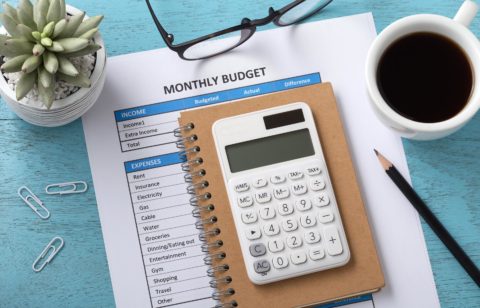You typically can get by on $30,000 in annual take-home pay. But you would probably live more comfortably on that money in Kansas than in New York City—given the much lower cost of living.
Still, it usually can be done no matter where you live. A salary calculator from payroll-processing company ADP indicates an American worker typically took home $30,000 a year based on a gross salary of $35,250 as of October 2022. How far the money goes depends on your location, expenses, and your discipline.
A Typical budget for someone who takes home $30,000
Here is a look at housing, food, health care, transportation and utility costs for somebody with a net income of $30,000, or $2,500 a month. Net income is the amount after taxes, medical insurance and other expenses are deducted.
Housing
Housing, whether it is a rent payment or mortgage payment, normally eats up the biggest chunk of your household budget.
Some experts recommend spending 30% of your gross income on housing. Using that percentage, if your gross income is $35,250 a year, the amount you should spend each month on housing works out to $881.
According to rental platform Zumper, the median rent for a one-bedroom apartment in Syracuse, New York, stood at $880 in September 2022. But just 150 miles to the west, the median rent for the same apartment in Buffalo, New York, was $1,130. So, the Syracuse apartment would fall within the recommended budget. The Buffalo apartment would break the budget, unless you are willing to live with a roommate.
Food
Generally, you should limit your food budget to 10% to 15% of your take-home pay. At $30,000, that would add up to $313 a month at the midpoint of the range (12.5%). Keep in mind that this assumes there is only one person in your household.
This food budget would be more than adequate in the Brownsville, Texas, metro area. There, the typical adult spent a little over $202 a month on groceries as of mid-2022. But you would fall well short of the $375 target in New York City and San Francisco, where the average person spent about $433 a month on groceries in 2021. Inflation is sure to raise these numbers in the near future.
Health care
Health care costs vary greatly from person to person. But health care spending makes up about 7% of a person’s income before taxes. So, if you multiply that percentage by the gross income figure of $35,250 a year, the monthly tab for health care would be $206. For a healthy person, that is a realistic number. But if you see doctors often, you would be hard-pressed to live within this limit.
Transportation
Experts typically suggest spending 10% to 15% of your net income on transportation. If you use 12.5% as the midpoint, monthly transportation costs should total $313 when you are taking home $30,000 a year. Many companies offer discounted transit costs.
Utilities
As a rule of thumb, you should spend 8% to 10% of your take-home pay on utilities. Taking into account yearly net income of $30,000, utilities should make up $225 (using 9%) of your monthly household budget. If you find yourself going over that number, raising the air conditioning or lowering the heat could help.
Entertainment and recreation
Some experts recommend spending anywhere from 5% to 10% of your take-home pay on entertainment and recreation. Using the midpoint of 7.5%, the monthly entertainment and recreation budget would be $188. Again, affordability is based on where you live.
Adding it all up
Now that we have calculated the dollar amount for each category, let’s look at the grand total.
- Monthly take-home pay: $2,500 ($30,000 a year)
- Monthly rent: $881
- Monthly food bill: $313
- Monthly health care expenses: $206
- Monthly transportation costs: $313
- Monthly utilities: $225
- Monthly entertainment and recreation: $188
Monthly take-home pay ($2,500) – monthly living expenses ($2,126) = $374
Using this formula, you would be left with $374 a month for other expenses. We didn’t include debt payments, savings and other common household budget items in our overall calculations. When coming up with our $30,000-a-year scenario, we assumed that this person carried no debt and wasn’t putting money into savings (for retirement or anything else). In other words, this budget is barebones and does not set you up for future financial success.
Housing: The biggest drain on your budget
As you can see, the biggest monthly expense for you and the majority of Americans is housing. So, depending on where you live, the $818 that would be available for monthly mortgage or rent payments might actually be enough to live on or might fall short.
What do you do if $818 isn’t enough for a place to live? Here are four tips:
- Move to a more affordable location. This is easier said than done. But if you are struggling to pay the mortgage or rent, you might need to consider moving to a lower-cost geographic area. In other words, you may want to say goodbye to higher-cost Los Angeles and hello to lower-cost Las Vegas.
- Get a roommate. Many of us had roommates in college. If you are wrestling with mortgage or rent payments, you may need to return to that lifestyle. This might mean taking in a roommate or moving in with someone. If you are really strapped for cash, you might consider temporarily sharing space with a generous friend or relative.
- Downsize to a smaller place. You could shave money off your monthly housing costs by moving into a smaller house or apartment with a lower monthly price tag.
- Refinance your mortgage. Depending on current interest rates, it might make sense to refinance your mortgage in hopes of reducing your monthly interest charges and payments. Keep in mind that refinancing involves fees and other closing costs. And in today’s inflationary environment, the interest rates are not in your favor.
Other ways to trim your cost of living
Aside from trying to make your housing more affordable, you can make other moves to cut costs:
1. Chip away at debt
Carrying credit card balances or other types of debt leaves you with less money for everyday expenses as well as savings for emergencies and retirement. To tackle your debts:
- Come up with a budget to track your monthly income and expenses.
- Avoid taking on more debt. You can do this by using fewer cards or no credit cards at all, and not taking out any new loans.
- Create a plan to wipe out debts. For instance, you might pay off your highest-interest debts first and then gradually move toward the lowest-interest debts. This is known as the “snowball method.”
- Consider getting a debt consolidation loan, which will give you one easier-to-handle monthly payment for some or all your debts. In addition, you probably will be able to reduce the overall amount of interest you are paying on that debt.
- Visit with a nonprofit credit counselor if you are unsure how to get a handle on your debts.
2. Avoid eating out
Dining at restaurants, picking up takeout or ordering delivered meals typically eats up a bigger share of your money than if you cooked and ate at home. Therefore, it is wise to save money by eating away from home only a couple days a week or maybe only on special occasions. The rest of the time (or perhaps all the time), fix home-cooked meals.
When you do eat out, look for cost savers such as special prices, BOGO and free delivery. And before you head to the grocery store, make a shopping list and stick to it. This can stop impulse purchases in its tracks.
3. Get rid of streaming subscriptions
Your subscriptions for streaming services like Netflix, Hulu and HBO Max deliver lots of entertainment. But that entertainment comes at a price. Do you really need every one of the streaming services you are paying for?
According to a survey taken in 2022, one-fourth of Americans spend at least $75 a month on streaming services. Over the course of a year, $75 a month adds up to $900. That is money that could cover one month’s rent in many places.
What if you can’t part with the streaming services you love? You might want to give up your cable TV subscription, if you still have one. According to one estimate, the average cable bill in the U.S. (excluding internet service) approaches $80 a month, or almost $960 a year.
4. Reduce your phone bill
In 2021, the average American paid more than $140 a month for cell phone service. But you can dial back that cost. For instance, you can shop around for a lower-cost service provider or bundle your service with friends and family to score a discount.
5. Shop around for insurance
It isn’t cheap to insure your home and car. But it certainly is important.
As of 2022, the typical monthly premium for homeowners’ insurance was $140, while the typical monthly premium for auto insurance was $148. Together, that’s nearly $250 a month.
To lower your home and auto insurance premiums, consider:
- Shopping around. compare the costs and coverage from at least three insurance companies. You might be able to find policies that provide good coverage at a better rate.
- Bundling coverage. When you buy home and auto insurance from the same company, you can often score what is known as a bundling discount. That discount normally ranges from 5% to 25%.
- Bump up your deductibles. Both home and auto insurance companies come with deductibles. This is the amount of money you pay out of pocket for a claim before an insurer’s payout kicks in. If you raise a deductible from, say, $500 to $1,000, you will save money with a lower premium.





